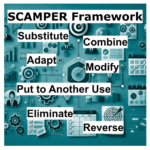Developing a new product can be exhilarating. Visions of market dominance and happy customers dance in your head. But before you get swept away by the excitement, take a deep breath and step back. There’s crucial groundwork to lay before diving into development. This article explores the essential considerations, requirements, and frameworks to gather before you even begin evaluating new product ideas.
MARKET PULSE
- Customer Needs
It all starts with understanding your target audience. Conduct thorough market research and surveys to identify unmet needs, pain points, and existing solutions. Analyze customer feedback and user data to discover hidden opportunities. Remember, a successful product solves a problem or fills a gap, not just adds another option to the clutter. - Market Trends
Stay ahead of the curve by researching emerging trends and technologies within your industry. Identify potential disruptions and anticipate future customer needs. Understanding the market landscape will help you develop a product that resonates with the times. - Competitor Analysis
Don’t operate in a vacuum. Closely study your competitors, their strengths and weaknesses, and their product offerings. This will help you differentiate your product and identify areas for competitive advantage.
PRODUCT VIABILITY
- Technical Feasibility
Can your product idea be realistically built with current technology and resources? Assess the required technical expertise, infrastructure, and potential development challenges. Ensure you have the capabilities to bring your vision to life. - Financial Considerations
Crunch the numbers! Estimate development costs, production expenses, marketing budget, and expected revenue. Create a comprehensive financial model to assess the project’s viability and potential ROI. Remember, financial feasibility is crucial for securing funding and ensuring long-term success. - Organizational Alignment
Does your new product idea align with your company’s overall mission, vision, and values? Will it require significant changes to existing processes or infrastructure? Ensure team buy-in and address any potential organizational hurdles before moving forward.
FRAMEWORK GUIDE:
Strategies
- Stage-Gate Model
This common framework divides the development process into stages with defined exit gates. At each gate, the project is evaluated based on predetermined criteria, ensuring that only viable ideas progress. - Lean Startup Methodology
This iterative approach emphasizes rapid prototyping, testing, and gathering customer feedback. It allows you to validate your assumptions early and pivot your idea before significant investments are made. - Blue Ocean Strategy
This framework seeks to create uncontested market space by offering novel products that cater to unmet needs. By focusing on innovation and differentiation, you can avoid the red ocean of fierce competition.
Idea Generation and Prioritization
- SCAMPER
This framework encourages creative thinking by asking a series of questions like “Substitute, Combine, Adapt, Modify, Put to other uses, Eliminate, Reverse?”. It can help you generate novel ideas and refine existing ones. - MosCow Method
This prioritization tool helps categorize features as Must-have, Should-have, Could-have, and Won’t-have, allowing you to focus on the most critical elements first. - RICE Score
This framework uses Reach, Impact, Confidence, and Effort to prioritize ideas based on their potential value and feasibility.
Development and Execution
- Agile Methodology
This iterative approach emphasizes continuous delivery and feedback loops. It allows you to adapt quickly to changing market conditions and customer needs. - Design Thinking*
This human-centered framework focuses on understanding user needs and creating solutions that are both desirable and feasible. It can help you develop products that resonate with your target audience. - Minimum Viable Product (MVP)
This involves creating a basic version of your product with core features and testing it with real users early on. This helps you gather feedback and iterate before investing heavily in development.
Business and Marketing
- Business Model Canvas
This framework helps visualize and map out the key components of your business model, including your value proposition, customer segments, channels, and revenue streams. - Value Proposition Canvas
This tool focuses on defining the value your product offers to customers and how it solves their problems. It helps ensure your product is truly differentiated and desirable. - Pirate Metrics
This framework uses key metrics like Acquisition, Activation, Revenue, Retention, and Referral to track the performance of your product and identify areas for improvement.
Gathering these requirements and employing appropriate frameworks will lay a solid foundation for your new product development journey. Remember, meticulous planning and evaluation before leaping into development can save you time, resources, and heartache in the long run.
Bonus Tip: Don’t be afraid to involve diverse perspectives! Gather input from cross-functional teams, external experts, and potential customers. A fresh perspective can uncover hidden challenges and spark innovative ideas.
Go forth and create something remarkable!






